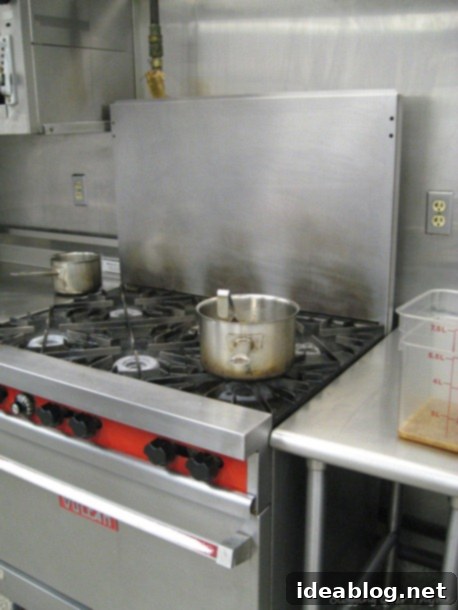My First Day at Culinary School: A Deep Dive into Early Mornings, French Onion Soup, and Essential Kitchen Skills
The dawn chorus was replaced by the insistent ring of my alarm clock this morning at a rather jarring 5:10 AM. Despite being profoundly tired – having woken up almost hourly from 2 AM onwards in a state of anxiety about oversleeping – I immediately sprang out of bed. The transition from sleep to action was swift, driven by the anticipation of my very first day at culinary school. My initial task was to don sweatpants and attempt to assemble a semblance of breakfast for the road. The thought of eating so early was far from appealing, making this seemingly simple act a genuine struggle. I have a strong feeling that adjusting to this drastically altered schedule will prove to be one of the biggest challenges of my new culinary journey.
By 5:45 AM, I was out the door, burdened by the essential tools of my new trade: my weighty knife kit, book bag, pristine uniform, and purse, all slung precariously over my shoulder. The journey to school was quick, and I arrived by 6:15 AM, eager but also slightly overwhelmed. The first order of business upon arrival was to head straight to our designated locker room. There, for only the second time ever, I meticulously changed into my full culinary uniform. Thankfully, the intricate art of tying a chef’s neckerchief was saved for a tutorial later in class, sparing me an early morning struggle with knots and folds.
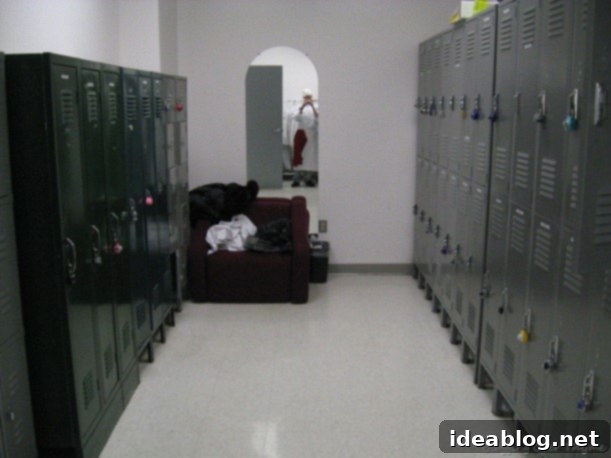
The Indispensable Morning Routine: Beyond the Alarm Clock
Our daily lecture officially commences each morning at 7:00 AM, but we received a crucial piece of advice yesterday: arriving early is not just recommended, it’s absolutely essential. This isn’t merely about allowing enough time to change into your uniform; it’s also about fulfilling a host of vital responsibilities in the kitchen before the day’s formal instruction begins. In Phase I of my demanding culinary program, the morning lecture typically kicks off with a comprehensive demonstration of the day’s menu. This is often followed by any additional theoretical lectures before we finally transition into the kitchen at around 9:00 AM to put our newly acquired knowledge into practice.
Before any of that can happen, however, a meticulous setup is required. Each morning, the lecture room itself needs to be fully stocked with all the necessary ingredients for the day’s menu. Staples like butter, salt, and pepper are always required, regardless of the dishes planned, highlighting their fundamental importance in culinary arts. Concurrently, the kitchen working tables must be thoroughly prepared with clean cutting boards, various work bowls, and an array of essential utensils. And, perhaps most critically for a group of early risers, we are also tasked with brewing fresh coffee for both the lecture participants and the rest of the school’s students. This preparatory work instills discipline and ensures a smooth, organized start to each intense day.
While I might sound like a seasoned professional describing this intricate routine, trust me, I definitely do not have it all down yet. Throughout this whirlwind first day, my classmates and I frequently exchanged confused glances, relying heavily on a process of trial and error and asking lots of clarifying questions to our patient chef instructors. It’s a steep learning curve, and the importance of communication and collaboration became immediately apparent.
Mastering the Classics: French Onion Soup (La Soupe à l’Oignon)
Today’s culinary agenda featured a timeless classic: French onion soup (LA SOUPE A L’OIGNON). This iconic dish is, apparently, a fundamental starting point for almost any reputable culinary program across the globe, serving as a benchmark for foundational skills. Funnily enough, despite its ubiquity, I had never made French onion soup in my entire life, so this was a significant and exciting first for me. While the concept might appear straightforward in theory, its successful execution undeniably demands a considerable amount of patience and an exceptionally watchful eye.
During the morning lecture, Chef Brian meticulously demonstrated the soup-making process. He thoroughly explained critical culinary techniques that are essential to French cuisine and beyond. This included an in-depth look at various dry-heat methods, which encompass techniques such as sautéing, grilling, broiling, and frying, all fundamental to developing flavor. He also elaborated on deglazing, a technique vital for capturing browned bits and building depth, and the art of caramelizing onions, which transforms humble onions into sweet, deeply flavored golden strands. Although the chef covered the menu in meticulous detail and elucidated the purpose of each ingredient and component, the actual quantities were explained somewhat vaguely. This deliberate approach is designed to foster proficiency in executing the techniques by taste and flavor intuition, rather than relying solely on the precise recreation of an exact recipe. It’s a lesson in developing a true chef’s palate.
One particularly insightful takeaway from the lecture was a practical tip: one onion yields one serving of French onion soup. This simple ratio is incredibly convenient for scaling recipes, I must say. Each student was responsible for preparing a two-to-three serving size of soup for the day. This generous quantity was not only destined to feed our esteemed chefs and fellow administration staff, but also ourselves and the pastry students at lunchtime. In a delightful culinary exchange, the pastry students reciprocate by bringing us their delectable creations. This mutual arrangement sounds dangerously appealing for the waistline!
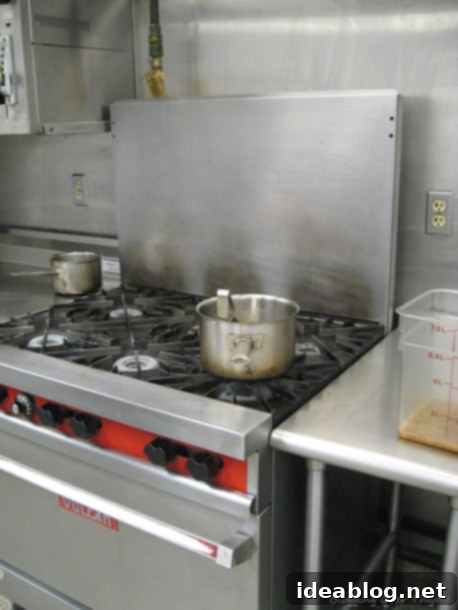
Decoding Kitchen Equipment: Pots, Pans, and Metals
Following the comprehensive soup demonstration, Chef Brian transitioned into a lengthy yet incredibly informative explanation of the vast array of different kitchen equipment and pots. This segment highlighted the nuanced distinctions between seemingly similar tools. For instance, he detailed the critical differences between a standard sauté pan, a deep soup pot, and a sautoir pot – the latter being a straight-sided, shallow pan often described as a hybrid of the two, adept at allowing for multiple techniques like simmering and sautéing. Understanding these distinctions is crucial for selecting the right tool for the job.
We also delved into a fascinating discussion on the pros and cons of various metals used in professional cookware, such as aluminum, anodized aluminum, and stainless steel. Each material possesses unique characteristics that influence its performance, specifically in terms of heat conductivity and reactivity with certain types of foods. For example, aluminum pots are known to impart a metallic taste to cream or acid-based sauces, making them less ideal for such preparations. In contrast, stainless steel is a non-reactive material, making it a versatile and safe choice for a wide range of ingredients. Throughout this rapid-fire delivery of essential knowledge, I found myself furiously scribbling notes in my notebook, trying desperately to absorb every single detail. It was an exceptionally interesting and highly informative session. I am confident that we will be revisiting and expanding upon all of this crucial information in much greater detail over the coming weeks, solidifying our foundational understanding.
Hands-On in the Kitchen: From Soup to Knife Skills
After the demo and lecture, the moment we had all been simultaneously nervous and excited for finally arrived: we headed into the bustling kitchen. We were essentially assigned to work tables, partnering with a fellow student. Our first instruction was simple: grab our soup ingredients and immediately get to work. The energy in the kitchen was palpable, a mix of focused intensity and eager anticipation.
In addition to perfecting our French Onion Soup, we were also responsible for preparing and serving LES CRUDITES. This traditional French appetizer consists of an assortment of thinly sliced raw vegetables, typically served with a dipping vinaigrette. While the vinaigrette was provided for us today – we’ll learn to make it from scratch tomorrow – this seemingly simple dish served a vital purpose: it was a meticulously designed exercise to practice and hone our knife skills. We received explicit instructions and hands-on teaching on how to execute perfect batonnets, which are precise 1/4” x 1/4” x 2 inch cuts. Everything we prepared was to be ready for service by 11:00 AM, which meant we were juggling both tasks simultaneously, including the critical detail of remembering to place the soup bowls in the oven to heat up for plating.
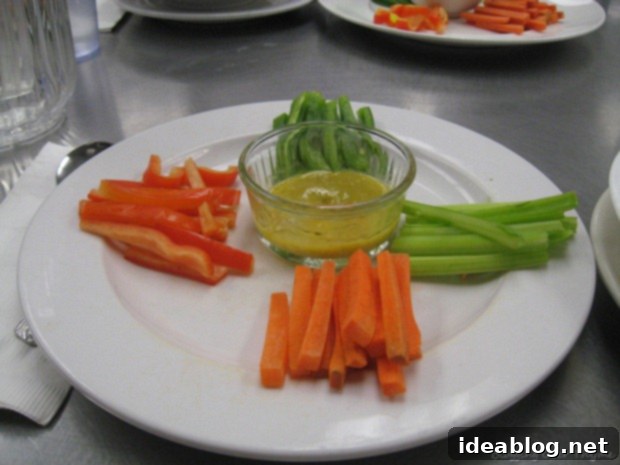
It’s abundantly clear that as our daily dishes become increasingly complicated, and as we are assigned even more tasks to complete within tight deadlines, the kitchen environment will undoubtedly become much more chaotic and potentially stressful. However, I am consciously trying not to look too far ahead to avoid getting overwhelmed. After all, it is still only the very first day, and we are not expected to know or execute everything perfectly right out of the gate. It’s a process of continuous learning and improvement.
First Day Successes and… a Minor Setback
Despite the inherent challenges of a first day, I was pleased to find that both of my dishes, the French Onion Soup and the Crudités, turned out remarkably well. Though I definitely recognize that I will need to dedicate considerable time this weekend to practicing my knife skills and achieving greater consistency in my cuts. I think one of the biggest adjustments I will have to make, and quickly get used to, is learning how to season my food properly with salt. It’s a nuanced art, but I did feel like I was starting to get the hang of it by the end of the day! My chef, it became quite clear, definitely appreciates his food well seasoned.
By 11:00 AM sharp, we had everything perfectly plated and ready for lunch service. I am permitted to carry a small point-and-shoot camera in class, which allowed me to capture a few snapshots of our culinary creations. While I truly miss the advanced capabilities of my DSLR and the magic of natural light, I hope these images still convey the essence of our efforts!
Of course, no first day in a professional kitchen would be complete without a minor mishap. I ended up cutting myself not once, but twice today! It was undeniably embarrassing, especially since I was the first in the class to do so – though certainly not the last, as the day progressed. The immediate consequence was being attended to by a chef and having to wear the infamous blue “finger condom,” as they affectionately call it. Ironically, neither of my cuts occurred while I was actively chopping or dicing anything. Instead, both incidents happened as I was simply removing knives from my kit and merely drying one of them. It sounds incredibly clumsy, but seriously – these professional-grade knives are incredibly sharp! They demand the utmost respect and caution.
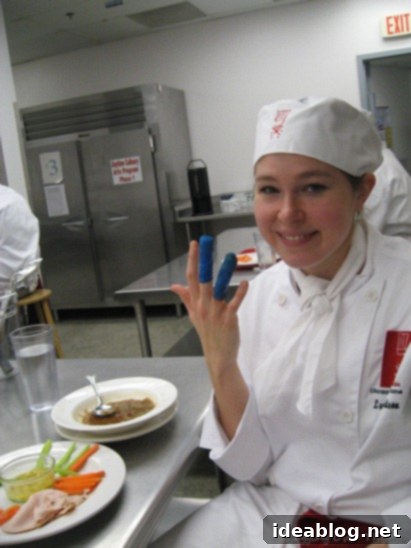
It certainly wasn’t my finest moment, but I suppose it was almost bound to happen at some point during the intense training. It served as a stark reminder of the constant vigilance required in a professional kitchen.
Afternoon Tasks: Stock Production and Future Preparations
After a demanding session in the kitchen and enjoying a well-deserved lunch – which was probably one of the healthiest meals we’ll have throughout the entire program! – our responsibilities shifted to the crucial task of kitchen cleanup. This involved not just tidying our individual stations but performing a multitude of other tasks to ensure the entire facility was left in impeccable order. I plan to provide a more detailed explanation of all these essential cleaning and organizational protocols in a future post, as it’s a significant part of a chef’s daily routine.
The remainder of the afternoon brought another new experience: breaking out our specialized bone knife for the very first time. Our mission? To meticulously trim the fat from a staggering four boxes worth of chicken backs! Our specific group is collectively responsible for producing the foundational stock for the entire culinary school, meaning this task will become a regular, integral part of our daily routine. In fact, Chef Brian informed us that we would be making stock about four times a week. That is an immense amount of trimming, and a testament to the scale of operations in a professional kitchen!
Looking ahead, tomorrow morning, we are already expected to arrive even earlier than today to get the stock simmering well before the morning lecture officially begins. I suppose that means an even earlier bedtime is steadily approaching. This demanding schedule reinforces the dedication and commitment required for a successful career in the culinary arts.
I hope you are enjoying these detailed posts about my culinary school experience. Your support this week as I embarked on this journey has been truly appreciated! Please feel free to let me know if there is anything specific you would like me to talk about in regards to culinary school, the curriculum, or daily life. I’m excited to share more of this adventure with you.
